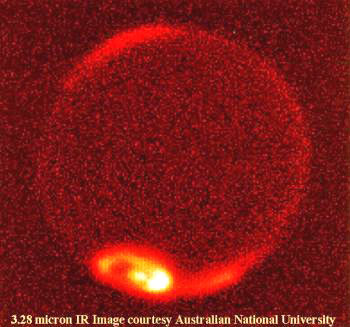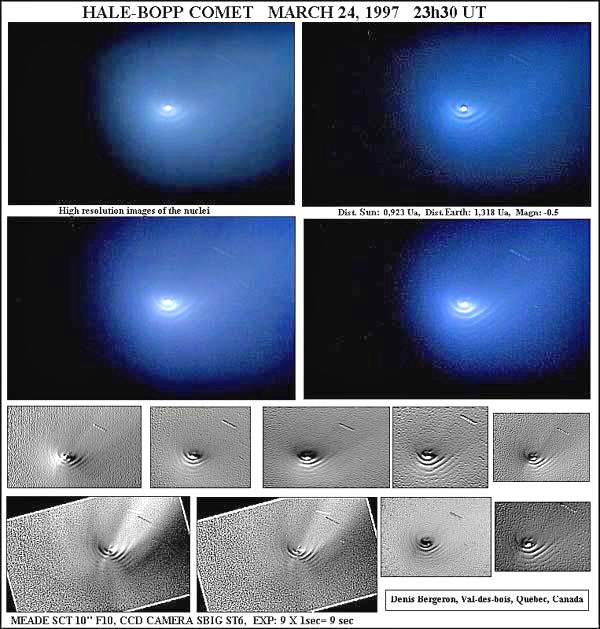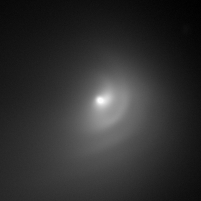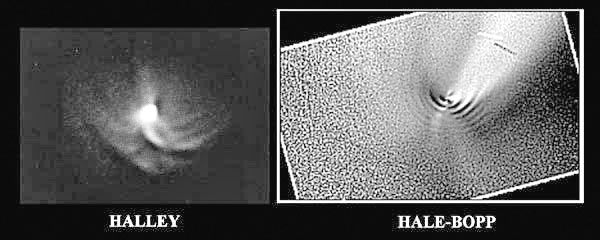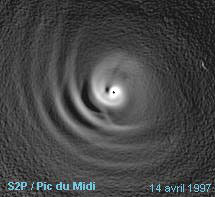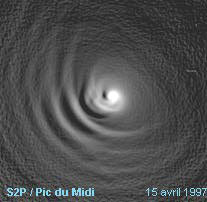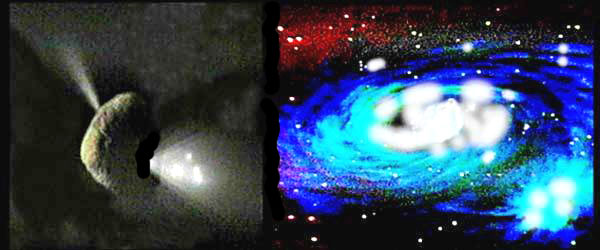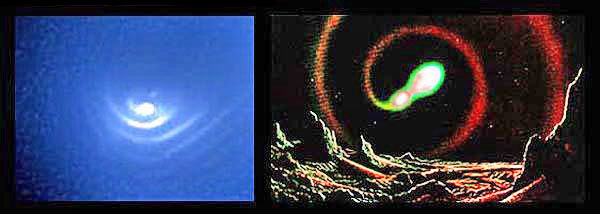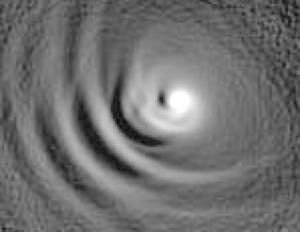|
from
TheEnterpriseMission Website
When one of the brightest comets in this
century sweeps grandly through the inner solar system after an
absence of millennia -- a spectacular object whose nucleus alone is
estimated by professional astronomers now to measure at least 25
miles across -- the apparition can be (and has been!) reasonably
termed "the event of a lifetime." Such is the current apparition of
"Hale-Bopp."
How special is about to be confirmed.
Van Flandern noticed that the orbits of
these "first timers," traced back against the reference points of
background stars, revealed an anomalous concentration of orbit
"crossing points" at two opposite locations along the common plane
of planetary orbits
to an astonishing degree -- the types of
orbits shared by Van Flandern’s "first-time comets"; each satellite
fragment, after completing half an orbit of the Earth, would
converge back on the plane of the original satellites’ orbit before
the "event" -- thus uniquely marking, via observable celestial
mechanics, the orbital site of the original explosion (below right).
Even more significant: Van Flandern realized that his Soviet weapons’ observations and resulting cometary comparisons was radical new evidence in support of a (by then) long-discarded model for solar system evolution.
Van Flandern realized that, if
"pristine" comets are still following trajectories strikingly
reminiscent of orbital explosions, then, maybe, those orbits were in
fact the direct result of a truly gigantic orbital explosion... like
the long-imagined explosion of an entire planet -- located in the
puzzling "gap" between the current orbits of Jupiter and Mars.
Dr. Van Flandern’s new celestial mechanics observations were seen by his colleagues as nothing less than an attempt to revive a long "discredited" solar system model.
The implications for ancient solar
system history, if Van Flandern turned out to be correct, would be
nothing less than staggering: one immediate effect would be to call
into question the true genesis of asteroids once again... after most
astronomers had thought their origins were long since settled.
Unlike the sun (or other stars), nuclear fusion was (and is) deemed theoretically impossible in planets, so Van Flandern’s "exploded planet model" lacked any known mechanism to "explode!" Undaunted by such theoretical considerations (after all, science is supposed to be built on verifiable, testable observations, not pre-conceived notions about what is or is not "possible"), Tom Van Flandern set about quietly accumulating centuries of cometary observations, coupled with the latest radar and NASA spacecraft observations of the asteroids.
Despite the (then) lack of theoretical
energy resources adequate to detonate a planet, Van Flandern’s
calculations, coupled with his reading of the spacecraft data,
convinced him more each day that -- novel energy sources
notwithstanding -- both comets and asteroids were somehow jointly
formed in a gargantuan primordial explosion circa 3 million years
ago... of a much more massive, former planetary member of the solar
system.
Because both asteroids and comets are literally only miles across (as opposed to planets, which measure thousands of times larger), directly seeing these tiny orbiting companions from the Earth has proven all-but-impossible. Historical "occultation" observations of asteroids, as they pass across chance background stars, has only given tantalizing hints of the existence of such invisible companions ("asteroid satellites," as they’ve been termed), causing some stars to blink on an off rapidly during rare encounters; are these tiny satellites, briefly obscuring background starlight in "satellite eclipses," as the fragments pass across the star? No one’s really sure.
What’s occurring deep inside a comet --
pictured in Van Flandern’s model also as a similar host of "whirling
fragments" circling each other (above), but this time generating
clouds of evaporated water and other gasses as they are heated by
strong sunlight, that ultimately expands as visible cometary "tails"
typically measuring millions of times longer -- is even more
impossible to accurately determine with existing observations... at
least so far, from Earth.
According to his detailed orbital calculations,
Comet nuclei, on the other hand (in the prevailing "Whipple" model -named in the 1950’s after a well-known Harvard astronomer, Dr. Fred C. Whipple), were generally viewed prior to Van Flandern as simply "single, dirty icebergs": frozen bits of the original solar system nebula (containing LOTS of water) that did not form a planet but continued orbiting the sun.
As they occasionally approached the center of the solar system (nudged into infalling orbits by distant passing stars, in this prevailing model) these "bergy bits" would be heated by increasing sunlight as they approached the inner solar system -- resulting in a spectacular release of their trapped gasses into space (below)... and the production of the brilliant "comet’s tail" -- pushed opposite the sun by the sheer pressure of raw, unfiltered sunlight.
The occasional "splitting" of these
cometary nuclei, observed with Earth-bound telescopes over the
years, was ascribed (in the mainstream" model) to the uneven solar
heating of this nucleus from intense sunlight -- resulting in
thermal stresses that (combined with tidal action from the sun)
resulted sometimes in a spectacular break-up of this "dirty
iceberg."
According to Van Flandern, the
calculable Jovian tidal forces on this comet at the time it
fragmented were actually insufficient to "tear it apart" (which was
the official NASA version for the splitting); what really separated
the (previously unobservable) 21 fragments, he argues, was the Jovian gravity field simply shearing off the orbiting satellites
into separate, parallel orbits -- as the comet dove deep into the
gravity "well" of Jupiter (above), and the resulting tides
overwhelmed the individual gravitational attraction of the
Shoemaker-Levy 9 satellites to each other.
The TV images relayed from the 6300-mile "Ida fly-by" instantly banished all further mainstream doubts as to whether asteroids have "satellite companions": Ida turned out to possess a mile-wide satellite (left, in circle), soon dubbed "Dactyl" (derived from Greek mythology regarding beings, called "Dactyli," who lived on Mount Ida in the company of Zeus).
Debate instantly began regarding whether this was just a "fluke": were "asteroid satellites" truly common, or was Ida somehow "special?" Van Flandern wryly observed soon after, in Sky and Telescope Magazine:
In the face of these "probabilities," the long-time opponents of such satellites eventually turned to what confirmation of Dactyl’s existence now "proved"; after denying for decades that any asteroids could (or did!) possess such satellites, these astronomers now argued that they had predicted them "all along"... as "a natural consequence of asteroidal collisions."
Ignored in this rising debate was Van Flandern’s clear priority, as well as his detailed celestial
mechanics calculations effectively eliminating such a "trivial"
origin for this new class of solar system objects; in fact, the
discovery of Ida’s "moon" effectively opened the door, in 1993, to
the awesome implications standing behind the entire, long-denied
existence of such satellites... that Ida (and thousands of other
asteroids, yet unseen in close-up) had acquired "moons" during that
almost unimaginable millions-of-years-old "event" which was the
source of Ida’s own existence: the explosion of a major member of
the solar system... sometime in this solar system’s "recent" past!
This meant that Shoemaker-Levy 9 was NOT
a "water-laden, frozen iceberg" at all -- but much more like an
asteroid; this, in turn, implied that it was "made of sterner stuff"
than merely ice, strongly implying that Jupiter’s tidal forces
during that first encounter truly would have been even more
ineffective in causing "fragmentation!" This left only "departing
asteroid satellites," under conflicting Jovian gravity, as a
reasonable explanation for Shoemaker-Levy 9’s extraordinary
dynamical behavior, in 1993 and 1994...
In examining a wide variety of Hale-Bopp images now available across the Web, two striking facts have become apparent to this writer: the total absence of any recent, large-scale, detailed close-ups of the nuclear region of Hale-Bopp, taken with a major telescope (2 meters, and up), including NASA Hubble imaging; and the startling, highly rhythmic "wave-like" behavior of this critical central region of the comet, even in the smaller-scale amateur imaging that is available.
Close examination of several time-lapse
"movies" (above image) that are available from the existing imaging has allowed us
to infer important information regarding processes occurring in this
nuclear region, below the resolution limits of the imaging itself.
Processes that now strongly imply the presence of one or more "Van Flandern satellites" orbiting in the central region of
Hale-Bopp. (Additional
Animations)
Thus, in this way we are putting forth
evidence here of striking dynamical behavior vis a vis Hale-Bopp,
which now strongly implies the existence of one or more satellites
orbiting inside the nuclear region, currently below the resolution
threshold of existing imagery.
The standard model for a cometary nucleus envisions a single "iceberg," blowing off material via a series of "sun-activated jets" (below, left), while Van Flandern’s "satellite model" is entirely different -- a central object, orbited by one or more smaller satellites... amid a cloud of additional orbiting "stuff" (below, right).
A comparison of these two models with the previous real images (above), clearly supports the "single object, jet-like model" for the Halley’s Comet single nucleus... and a very different process apparently occurring deep inside Hale-Bopp’s central region. It is highly tempting to ascribe the highly ordered image of Hale-Bopp to the precisely-controlled physics expected of a rhythmically-orbiting set of objects in its nucleus... i.e. Van Flandern’s satellites!
The key to deciding if Van Flandern’s model is correct vis a vis Hale-Bopp (at least until much higher-definition images are officially released), would seem to lie in clever application of known astronomy and physics to the "unobservable."
Surprisingly, if you compare the currently visible activity within the nucleus of Hale-Bopp (below, left and bottom) with a model of a double-star system ejecting an expanding atmosphere past one of its companions via gravitational effects through the "L-2 lobe" (below, right) -- the resulting comparison is eerily similar to time-lapse motion images of Hale-Bopp!
The implications for both Van Flandern’s "satellite model," as well as a shattering, potential "hidden catastrophic solar system history," is obvious...
|

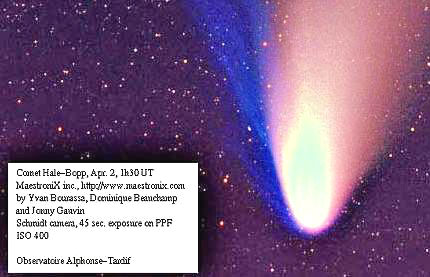
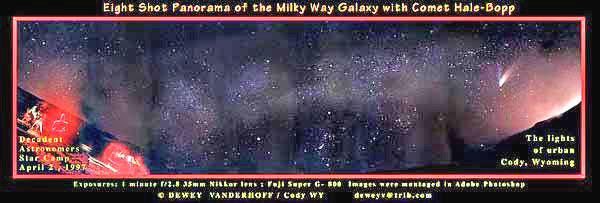
 Naval
Observatory, Dr. Thomas Van Flandern (
Naval
Observatory, Dr. Thomas Van Flandern (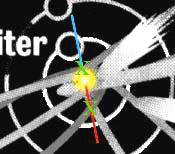 of
the solar system [marked by the green "Xs" on the B&W enlargement
from a comet orbit/solar system diagram left]. See
of
the solar system [marked by the green "Xs" on the B&W enlargement
from a comet orbit/solar system diagram left]. See
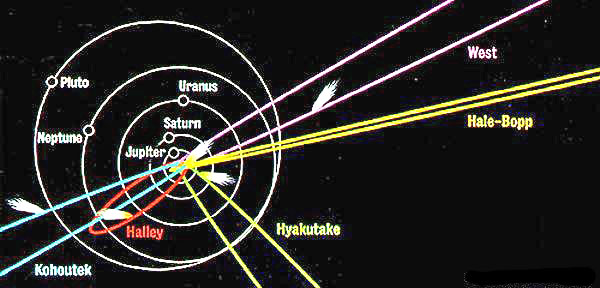
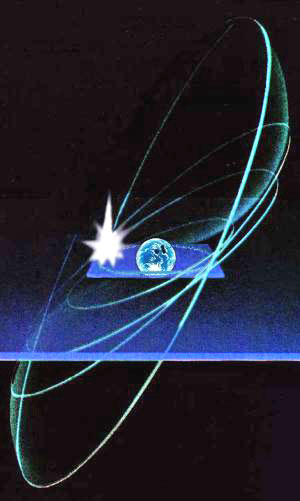 behavior
a striking model for the then (still) mysterious "genesis of Very
Long Period Comets" (those whose first-time orbits carefully
preserve their original parameters, before repeated passages past
inner solar system planets are able to destroy this vital
information by irrevocably changing their recurring orbits).
behavior
a striking model for the then (still) mysterious "genesis of Very
Long Period Comets" (those whose first-time orbits carefully
preserve their original parameters, before repeated passages past
inner solar system planets are able to destroy this vital
information by irrevocably changing their recurring orbits). 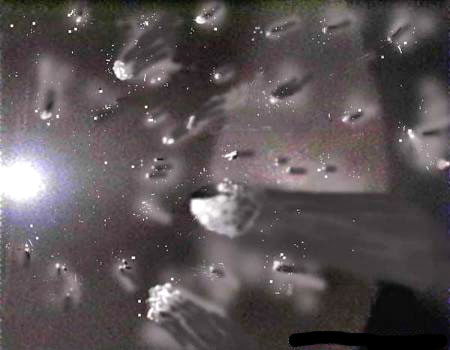
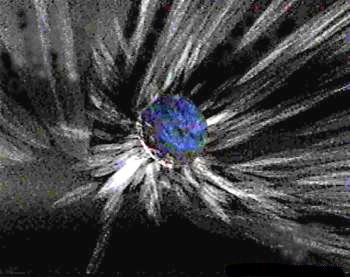
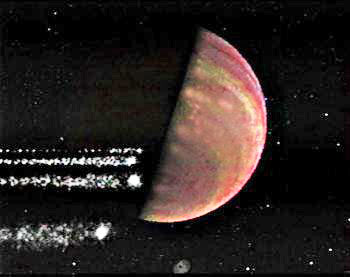
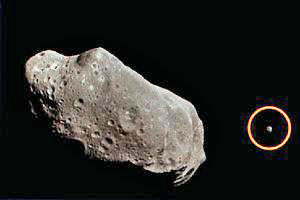 arrive until
December, 1995), the unmanned Galileo spacecraft flew by the second
of two targeted asteroids en route: 33-mile diameter "243 Ida."
arrive until
December, 1995), the unmanned Galileo spacecraft flew by the second
of two targeted asteroids en route: 33-mile diameter "243 Ida."
